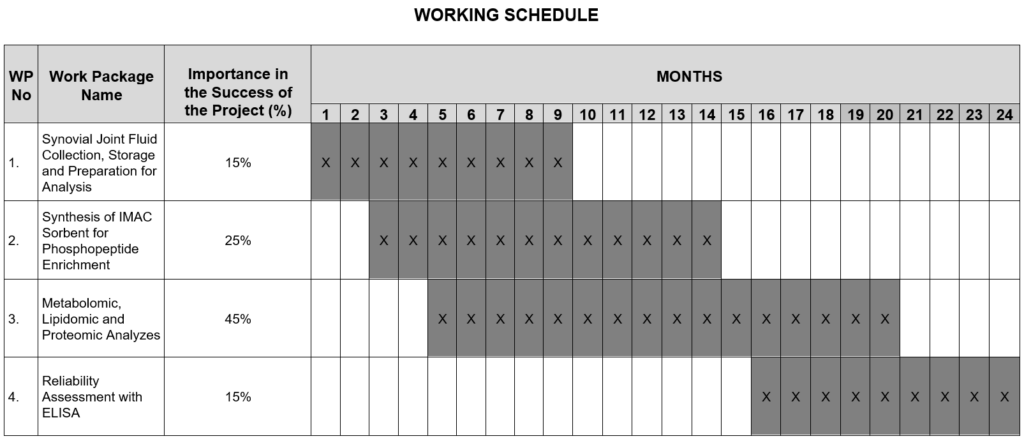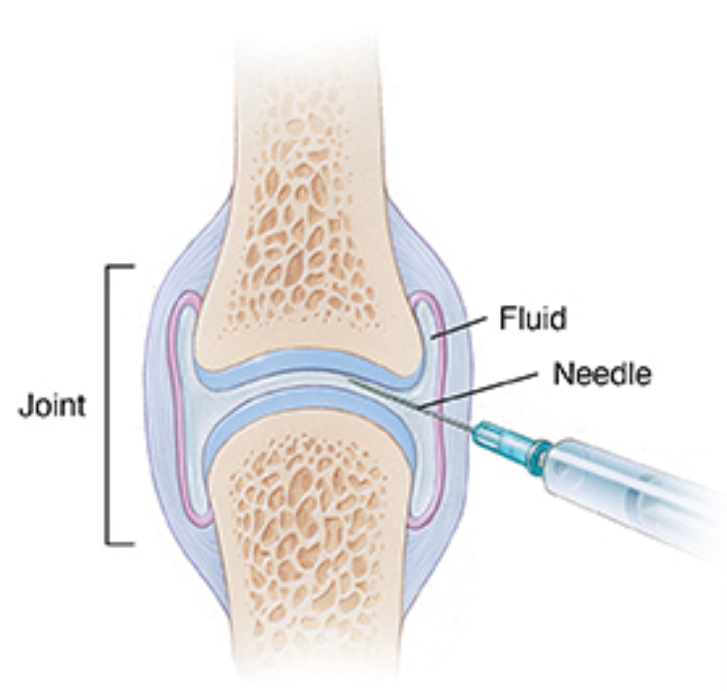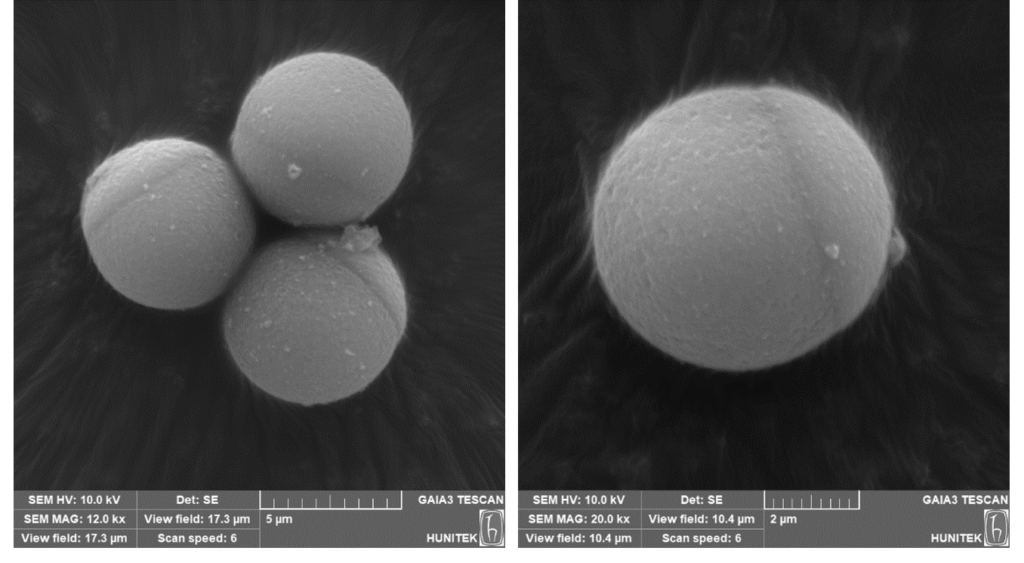1. Project Timeline

Project Initiation Date: 15/03/2024
Project End Date: 15/03/2026

2. Introduction
Diagnosis of diseases, monitoring of their course and treatment efficacy has been the leading focus of medical science. Conventional methods make the early diagnosis of the disease and the monitoring of its progression difficult. Advances in laboratory technologies and chromatographic methods provided the opportunity to examine clinical pictures at the molecular level; offered time, labor and cost effective alternatives. Diagnosis of arthropathies, monitoring of the course and evaluation of treatment efficacy are generally made with the patient through questionnaires based on qualitative parameters. The development of an analytical method with which quantitative comparisons can be made will benefit clinical processes, especially treatment planning. Although synovial joint fluid is a lubricant for the joint area, it is a transfer medium for the cartilage extracellular matrix and molecules released during the vascular circulation. Structures such as the synovium, meniscus, ligament, and joint capsule express protein through secretion into the synovial joint fluid. Anabolites and catabolites formed as a result of regeneration/degeneration events for bone and cartilage homeostasis also diffuse into the synovial joint fluid. Therefore, an abnormal situation that can be experienced in the tissues and systems with which the synovial joint fluid interacts is reflected in the synovial joint fluid at the molecular level. The examination of synovial joint fluid, which is the biological matrix containing the biomarkers that are the focus of omics studies, has been carried out by many working groups. What is important here is to demonstrate the validity and reliability of the experimental design and results. We aim to present advanced research results on osteoarthritis, the pathophysiology of which has not yet been elucidated, by omic analysis of synovial joint fluid.
3. Aim and Goals
The aim of the project is to perform proteomic, phosphoproteomic, metabolomic and lipidomic/phospholipidomic analyzes with LC-QTOF-MS to demonstrate the multiomic approach, following the development, synthesis and performance evaluation of the IMAC sorbent that can be used in the diagnosis and treatment of OA. The omics information obtained will be evaluated bioinformatically and used to identify phenotypic, clinical, molecular and therapeutic endotypes of OA. In addition, it is thought that new molecules specific to different processes of the disease, such as inflammatory, metabolic, cellular and immunological periods, can be revealed. The information obtained will be able to reveal diagnoses and treatments specific to the person and the period of the disease in the future.
The following goals were determined according to the declared purpose of the project:
(1) Producing SiO2@PEI@Ti(IV) IMAC sorbent and revealing its structural properties,
(2) Demonstrating the phosphoprotein enrichment performance of SiO2@PEI@Ti(IV) IMAC sorbent,
(3) Demonstrating the usability of SiO2@PEI@Ti(IV) IMAC sorbent in the phosphoproteomic examination of joint fluid,
(4) Using this sorbent, elucidating the phosphoproteins/phosphopeptides present in the joint fluid as biomarkers,
(5) Carrying out untargeted proteomic, lipidomic and targeted metabolomic studies to demonstrate the multiomic approach,
(6) Comparison of the phospholipid enrichment performance of this sorbet from intraarticular fluid with commercial kits and its use in the detection of phospholipid markers and
(7) Paving the way for the identification of new diagnostic and treatment molecules by evaluating omics data and data obtained from ELISA together.
4. Work Packages

Work Package 1 – Synovial Joint Fluid Collection, Storage and Preparation for Analysis
- 1.1. Aspirating synovial joint fluid from patients
- 1.2. Preparation of synovial joint fluid for analysis
- 1.3. Storage of synovial joint fluid
Deliverables of WP1:
- 1.1. A protocol for collecting synovial joint fluid from patients will be designed and published as technical information on the official web page.
- 1.2. A protocol for the preparation of synovial joint fluid for analysis will be desgned and published as technical information on the official web page.
- 1.3. Synovial joint fluid storage protocol will be desgned and published as technical information on the official web page.

Work Package 2 -Synthesis of IMAC Sorbent for Phosphopeptide Enrichment
- 2.1. Synthesis and characterization of Immobilized Metal Affinity Chromatography (IMAC) sorbents in microsphere form
- 2.2. Phosphopeptide enrichment in reference standard protein and synovial fluid
- 2.3. Investigation of phosphopeptide isolation performance of microspheres by mass spectrometry
- 2.4. Comparison of phospholipid isolation performance of microspheres with commercial kits
Deliverables of WP2:
- 2.1. Methods and images for the development and characterization of immobilized metal affinity chromatography (IMAC) sorbents in microsphere form will be published as technical information on the official web page.
- 2.2. The method for phosphopeptide enrichment in reference standard protein and synovial fluid will be published as technical information on the official web page.
- 2.3. The data obtained from the investigation of the phosphopeptide isolation performance of microspheres by mass spectrometry will be stored to be used in the article and presented at the congress. It is planned to make a presentation at the congresses between 12-24 months. Additionally, publish an article on sorbent synthesis is planned within 12-24 months.
- 2.4. When the phospholipid isolation performance of microspheres is compared with commercial kits, a result similar to and/or better than the commercial kits (based on matching criteria in terms of peak number and commercial mass profile) is obtained, this data will be published in reputable scientific journals “sample preparation – material technology” between 12-24 months. It is planned to be published in special issues on the subject.

Work Package 3 – Metabolomic, Lipidomic and Proteomic Analyzes
- 3.1. Examination of synovial joint fluid at the metabolome level
- 3.2. Examination of synovial joint fluid at the lipidome level
- 3.3. Examination of synovial joint fluid at the proteome level
Deliverables of WP3:
- 3.1. The protocol for examining joint fluid with omic technology will be published on the official web pageas technical information.
- 3.2. After the omic analyzes are completed, a brochure will be printed and a bulletin will be published. Information will also be announced via social media. A workshop on omics analysis of joint fluid will be planned and will be linked to the CA21110 COST Action.
- 3.3. Omics analysis results from synovial fluid will be presented at the scientific congress and then an article will be published.

Work Package 4 – Reliability Assessment with ELISA
- 4.1. Quantification of inflammation markers in synovial joint fluid
- 4.2. Determining the amount of cartilage formation and destruction markers in synovial joint fluid
- 4.3. Comparative evaluation of Omics and ELISA data
Deliverables of WP4:
- 4.1. The amounts of inflammation markers determined in the joint fluid will be present as mean and standard deviation and presented as graphs. A protocol for the analysis of joint fluid in the Multiplex ELISA system will be designed and published as technical information on the official web page. The information obtained will be presented at scientific congresses, meetings and workshops.
- 4.2. The amounts of cartilage formation and destruction markers determined in the joint fluid will be present as mean and standard deviation and presented as graphs. The method will be published as a technical note on the official web page and meaningful data will be presented at congresses and reflected in the article.
- 4.3. A scientific article will be published after ELISA and omics data are compared and interpreted. A link to this publication will be provided on the official web page after the publication. Broadcast information will be announced through media and social media. The final output of the project will be shared with stakeholders at the COST-Action CA21110 regular meetings. A training school and workshop will be organized for ELISA study. One doctoral and one master’s scholar will be trained in the techniques and technologies used. If originality can be found in the process or result, a national patent application will be made.